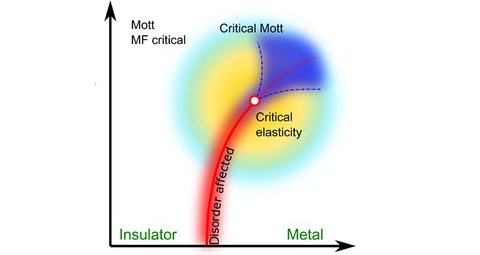Dec 14, 2016
Research: Universality class of the Mott transition
The fate of a metal with a half-filled conduction band crucially depends on the strength of the effective electron-electron interaction. When it is weak metallicity prevails, but a so-called Mott insulator is realized for strong interactions. At low temperatures, the metal is separated from the Mott insulator by a line of first order transitions which terminates in a critical endpoint similar to the liquid-gas transition. By virtue of this analogy, it was argued for many years that the universal critical properties close to the Mott endpoint are governed by the Ising universality class.
This viewpoint was challenged recently [1] suggesting that the shear stiffness of the atomic crystal — a property that liquids and gases are lacking — crucially influences the criticality. Whenever the crystal lattice is involved at an endpoint, the fluctuations remain non-critical due to long-range shear forces resulting in fluctuationless mean-field behavior. A hallmark of such an elastic coupling is a breakdown of Hooke’s law at the Mott transition. A collaboration between the TU Dresden and the University of Frankfurt now verified this prediction using high-resolution dilatometry for an organic Mott insulator as reported in Science Advances [2].
[1] Mott Metal-Insulator Transition on Compressible Lattices,
M. Zacharias, L. Bartosch, and M. Garst, Phys. Rev. Lett. 109, 176401 (2012).
[2] Breakdown of Hooke’s law of elasticity at the Mott critical endpoint in an organic conductor, E. Gati, M. Garst, R. S. Manna, U. Tutsch, B. Wolf, L. Bartosch, H. Schubert, T. Sasaki, J. A. Schlueter, and M. Lang, Science Advances 2, e1601646 (2016).

